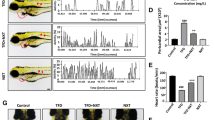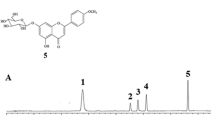Abstract
Tri-Circulator (TC) is a product comprising coenzyme Q10 (CoQ10), Salvia miltiorrhiza, and Panax notoginseng. Individually, each of these constituents has demonstrated protective effects on myocardial injury. The purpose of this study is to evaluate the protective efficacy of TC on heart function and compare the differential effects between CoQ10 and TC. Two myocardial injury models of zebrafish, the hypoxia-reoxygenation model (H/R) and the isoproterenol (ISO, a β-receptor agonist) model, were used in this experiment. The zebrafish subjects were divided into 4 groups: control, H/R, TC, and CoQ10. Heart rate, stroke volume (SV), cardiac output (CO), ejection fraction (EF), fractional area change (FAC), and pericardial height were monitored to assess changes in heart function. The gene expression of atrial natriuretic peptide (ANP) and brain natriuretic peptide (BNP) was studied as markers of injury/stress. TC significantly suppresses elevated heart rate induced by H/R and prevents the decrease of heart rate induced by ISO. It alleviates the pericardial infusion induced by ISO, whereas CoQ10 does not possess a similar effect. Both TC and CoQ10 significantly inhibit the decline in SV, CO, EF, and FAC induced by H/R and ISO, and suppress the expression of ANP and BNP in cardiomyocytes induced by ISO. It is noteworthy that TC demonstrates a more pronounced effect on EF, FAC, ANP, and BNP gene expression compared to CoQ10. Both TC and CoQ10 have a protective effect on myocardial injury of zebrafish. However, TC exhibits a greater efficacy compared to CoQ10 alone in mitigating myocardial injury.




Similar content being viewed by others
Data Availability
The data used to support the findings of this study are available from the corresponding author upon request.
Abbreviations
- ANP:
-
Atrial natriuretic peptide
- BNP:
-
Brain natriuretic peptide
- CoQ10:
-
Coenzyme Q10
- CO:
-
Cardiac output
- DPF:
-
Day post fertilization
- EF:
-
Ejection fraction
- FAC:
-
Fractional area change
- H/R:
-
Hypoxia-reoxygenation
- ISO:
-
Isoproterenol
- PN:
-
Panax notoginseng
- SM:
-
Salvia miltiorrhiza
- SV:
-
Stroke-volume
- TC:
-
Tri-circulator
References
Zalewski, J., et al. (2021). Complicating acute myocardial infarction. Current status and unresolved targets for subsequent research. Journal of Clinical Medicine, 10(24), 5904.
Addae-Mensah, K., Revels, J., & Febbo, J. (2022). Pitfalls and pearls in the imaging of cardiac ischemia. Seminars in Ultrasound CT MR, 43(3), 184–193.
Lindahl, B., et al. (2017). Medical therapy for secondary prevention and long-term outcome in patients with myocardial infarction with nonobstructive coronary artery disease. Circulation, 135(16), 1481–1489.
Salvio, G., et al. (2021). Coenzyme Q10 and male infertility: A systematic review. Antioxidants (Basel, Switzerland), 10(6), 874.
Aaseth, J., Alexander, J., & Alehagen, U. (2021). Coenzyme Q supplementation—In ageing and disease. Mechanisms of Ageing and Development, 197, 111521.
Hedman, E., & Itkonen, O. (2021). Mitochondrial coenzyme Q10 determination via isotope dilution liquid chromatography-tandem mass spectrometry. Methods in Molecular Biology, 2275, 329–339.
Rabanal-Ruiz, Y., Llanos-González, E., & Alcain, F. (2021). The use of coenzyme Q10 in cardiovascular diseases. Antioxidants (Basel, Switzerland), 10(5), 755.
Chen, W., & Chen, G. (2017). Danshen (Salvia miltiorrhiza Bunge): A prospective healing sage for cardiovascular diseases. Current Pharmaceutical Design, 23(34), 5125–5135.
Yang, F., et al. (2020). Panax notoginseng for cerebral ischemia: A systematic review. The American Journal of Chinese Medicine, 48(6), 1331–1351.
Lin, R., et al. (2021). Salvia miltiorrhiza and the volatile of attenuate chronic myocardial ischemia injury in a pig model: A metabonomic approach for the mechanism study. Oxidative Medicine and Cellular Longevity, 2021, 8840896.
Yu, J., et al. (2015). Danshensu protects isolated heart against ischemia reperfusion injury through activation of Akt/ERK1/2/Nrf2 signaling. International Journal of Clinical and Experimental Medicine, 8(9), 14793–14804.
Qiao, Z., & Xu, Y. (2016). Salvianolic acid B alleviating myocardium injury in ischemia reperfusion rats. African Journal of Traditional, Complementary, and Alternative Medicines: AJTCAM, 13(4), 157–161.
Meng, Y., et al. (2016). Danshensu protects against ischemia/reperfusion injury and inhibits the apoptosis of H9c2 cells by reducing the calcium overload through the p-JNK-NF-κB-TRPC6 pathway. International Journal of Molecular Medicine, 37(1), 258–266.
Li, D., et al. (2016). Salvianolic acid B induced upregulation of miR-30a protects cardiac myocytes from ischemia/reperfusion injury. BMC Complementary and Alternative Medicine, 16, 336.
Hu, H., et al. (2015). Protective effects of tanshinone IIA on myocardial ischemia reperfusion injury by reducing oxidative stress, HMGB1 expression, and inflammatory reaction. Pharmaceutical Biology, 53(12), 1752–1758.
Yuan, X., et al. (2017). Salvianolic acid A protects against myocardial ischemia/reperfusion injury by reducing platelet activation and inflammation. Experimental and Therapeutic Medicine, 14(2), 961–966.
Duan, L., et al. (2017). Panax notoginseng saponins for treating coronary artery disease: A functional and mechanistic overview. Frontiers in Pharmacology, 8, 702.
Wang, D., et al. (2021). Cardioprotection of Panax notoginseng saponins against acute myocardial infarction and heart failure through inducing autophagy. Biomedicine & Pharmacotherapy = Biomedecine & Pharmacotherapie, 136, 111287.
Zhu, J., et al. (2021). Difenoconazole induces cardiovascular toxicity through oxidative stress-mediated apoptosis in early life stages of zebrafish (Danio rerio). Ecotoxicology and Environmental Safety, 216, 112227.
Narumanchi, S., et al. (2021). Zebrafish heart failure models. Frontiers in Cell and Developmental Biology, 9, 662583.
Zou, X., et al. (2019). A Novel zebrafish larvae hypoxia/reoxygenation model for assessing myocardial ischemia/reperfusion injury. Zebrafish, 16(5), 434–442.
Khdhiri, E., et al. (2021). Cardiopreventive capacity of a novel (E)-N′-(1-(7-methoxy-2-oxo-2H-chromen-3-yl) ethylidene)-4-methylbenzenesulfonohydrazide against isoproterenol-induced myocardial infarction by moderating biochemical, oxidative stress, and histological parameters. Journal of Biochemical and Molecular, 35, e22747.
Gou, D., et al. (2021). Mog1 knockout causes cardiac hypertrophy and heart failure by downregulating tbx5-cryab-hspb2 signalling in zebrafish. Acta Physiologica (Oxford, England), 231(3), e13567.
Pasha, R., & Moon, T. W. (2017). Coenzyme Q10 protects against statin-induced myotoxicity in zebrafish larvae (Danio rerio). Environmental Toxicology and Pharmacology, 52, 150–160.
Sawahata, M., et al. (2021). In vivo brain ischemia-reperfusion model induced by hypoxia-reoxygenation using zebrafish larvae. Brain Research Bulletin, 173, 45–52.
Kossack, M., et al. (2017). Induction of cardiac dysfunction in developing and adult zebrafish by chronic isoproterenol stimulation. Journal of Molecular and Cellular Cardiology, 108, 95–105.
Perumal, E., et al. (2021). Mitigation of arsenic induced developmental cardiotoxicity by ferulic acid in zebrafish. Comparative biochemistry and physiology. Toxicology & Pharmacology: CBP, 244, 109021.
Derrick, C., et al. (2021). Asymmetric Hapln1a drives regionalised cardiac ECM expansion and promotes heart morphogenesis in zebrafish development. Cardiovascular Research. https://doi.org/10.1093/cvr/cvab004
Koopman, C., et al. (2021). grimeThe zebrafish mutant uncovers an evolutionarily conserved role for Tmem161b in the control of cardiac rhythm. Proceedings of the National Academy of Sciences of the United States of America. https://doi.org/10.1073/pnas.2018220118
Saini, R. (2011). Coenzyme Q10: The essential nutrient. Journal of Pharmacy & Bioallied Sciences, 3(3), 466–467.
Zozina, V., et al. (2018). Coenzyme Q10 in cardiovascular and metabolic diseases: Current state of the problem. Current Cardiology Reviews, 14(3), 164–174.
Ren, J., et al. (2019). Salvia miltiorrhiza in treating cardiovascular diseases: A review on its pharmacological and clinical applications. Frontiers in Pharmacology, 10, 753.
Yang, X., et al. (2014). Protective effects of panax notoginseng saponins on cardiovascular diseases: A comprehensive overview of experimental studies. Evidence-Based Complementary and Alternative Medicine: ECAM, 2014, 204840.
Zhou, X., et al. (2016). Synergistic effects of Danshen (Salvia miltiorrhiza Radix et Rhizoma) and Sanqi (Notoginseng Radix et Rhizoma) combination in inhibiting inflammation mediators in RAW264.7 Cells. BioMed Research International, 2016, 5758195.
Han, J., et al., Traditional Chinese drug comprising Danshen extracts and Sanqi extracts and use thereof. US.
Ren-an, Q., et al. (2014). Study of the protective mechanisms of compound Danshen Tablet (Fufang Danshen Pian) against myocardial ischemia/reperfusion injury via the Akt-eNOS signaling pathway in rats. Journal of Ethnopharmacology, 156, 190–198.
Chengode, S. (2016). Left ventricular global systolic function assessment by echocardiography. Annals of Cardiac Anaesthesia, 19, S26–S34.
Potter, L., et al. (2009). Natriuretic peptides: Their structures, receptors, physiologic functions and therapeutic applications. Handbook of Experimental Pharmacology, 191, 341–366.
Sun, S., et al. (2018). Dendropanax morbifera prevents cardiomyocyte hypertrophy by inhibiting the Sp1/GATA4 pathway. American Journal of Chinese Medicine, 46(5), 1021–1044.
Acknowledgements
This work is supported by TCM Health Education & Research Center, USA.
Author information
Authors and Affiliations
Contributions
YX, RW, and SK contributed toward conceptualization, writing–review & editing, formal analysis, writing–original draft, and methodology. TZ contributed toward formal analysis, and writing–original draft. YX contributed toward methodology and software. YS contributed toward validation. HN contributed toward conceptualization, writing–review & editing, funding acquisition, supervision, methodology, and project administration.
Corresponding author
Ethics declarations
Competing interests
The authors declare no competing interests.
Additional information
Handling Editor: Daniel Conklin.
Publisher's Note
Springer Nature remains neutral with regard to jurisdictional claims in published maps and institutional affiliations.
Rights and permissions
Springer Nature or its licensor (e.g. a society or other partner) holds exclusive rights to this article under a publishing agreement with the author(s) or other rightsholder(s); author self-archiving of the accepted manuscript version of this article is solely governed by the terms of such publishing agreement and applicable law.
About this article
Cite this article
Xiao, Y., Wang, R., Kong, S. et al. Comparison of Protective Effect of Tri-circulator and Coenzyme Q10 on Myocardial Injury and the Mechanism Study by Zebrafish Model. Cardiovasc Toxicol 24, 258–265 (2024). https://doi.org/10.1007/s12012-024-09828-7
Received:
Accepted:
Published:
Issue Date:
DOI: https://doi.org/10.1007/s12012-024-09828-7




